21 Types Of SMALL Birds In Ohio (ID Guide With Photos)
Did you recently come across a small bird in the state of Ohio, and want to know what species it was?
Identifying small birds in the Buckeye State is not as easy as it might seem, since there are many bird species in Ohio that are on the small side.
To help you identify the bird you saw, we’ll cover the most important small birds of Ohio in this article.
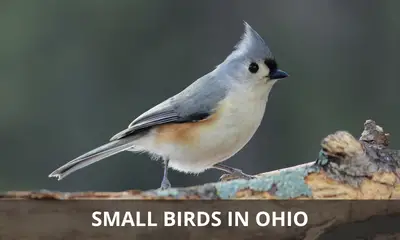
What are the types of small birds in Ohio?
The 21 types of small birds commonly found in Ohio are:
- Carolina Wren
- Black-capped Chickadee
- Ruby-throated Hummingbird
- House Wren
- American Goldfinch
- Blue-gray Gnatcatcher
- Palm Warbler
- Gray Catbird
- Tufted Titmouse
- Tree Swallow
- Downy Woodpecker
- Eastern Towhee
- Common Yellowthroat
- Scarlet Tanager
- Eastern Bluebird
- House Finch
- Northern Cardinal
- House Sparrow
- Yellow Warbler
- Red-breasted Nuthatch
- Golden-crowned Kinglet
- Brown Creeper
While many of these birds are found year-round in Ohio, others only occur in the state during the breeding season in summer.
Yet other species are winter visitors in Ohio, and some are vagrants that only rarely occur in the state (more on that below).
Now let’s dive into the details, and take a closer look at each of these bird species in order to get the full scoop:
Carolina Wren
Scientific name: Thryothorus ludovicianus

The Carolina Wren is a common little garden bird with chestnut brown upperparts and creamy white underparts. Wings and tails have dark brown barring.
Males and females look alike, as do young individuals. The Carolina Wren is a non-migratory species, and can be spotted all year round in the state of Ohio.
It is a familiar tiny bird, which can be found in backyards, scrubland, and forests. It feeds mostly on insects and other small invertebrates.
Black-capped Chickadee
Scientific name: Poecile atricapillus
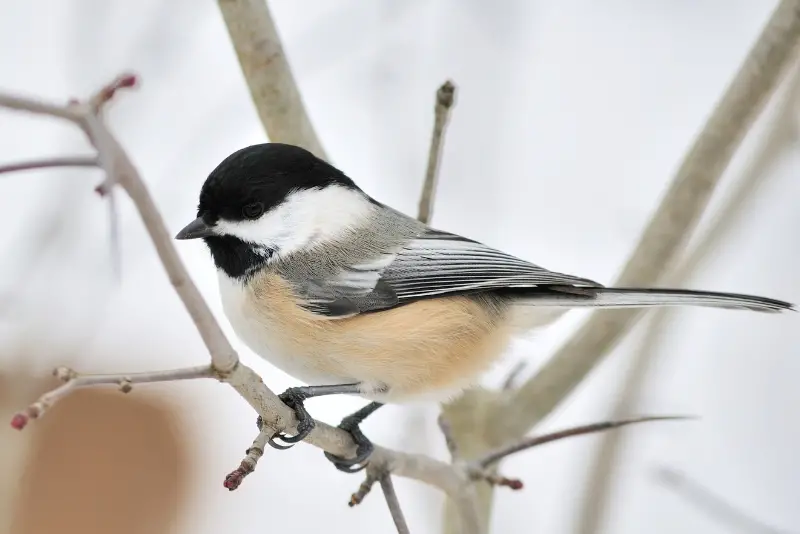
The Black-capped Chickadee is a widespread bird species in North America. Both sexes look similar, and have gray backs with buff underparts.
Their most distinguishing feature is the black cap and the black throat, which contrasts with the bright white cheeks.
This chickadee is present year-round in Ohio, where it favors a variety of forest habitats as well as backyards.
These small chickadees are regular visitors at bird feeders, and also accept nestboxes.
Ruby-throated Hummingbird
Scientific name: Archilochus colubris
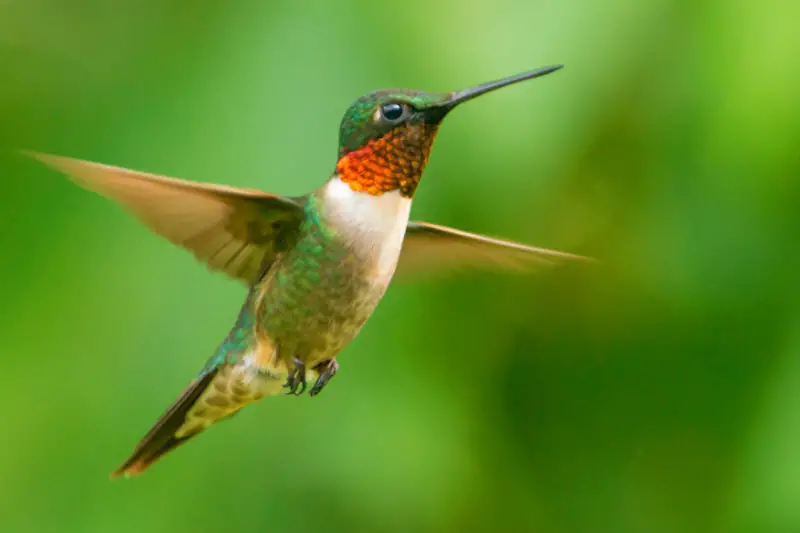
The Ruby-throated Hummingbird is the smallest bird in Ohio. Weighing just 0.1 ounces, it is a truly tiny bird when you compare it to other species.
The male has a black throat that reflects flashes of ruby red when it catches the sunlight.
Similar to other Hummingbirds, it can fly straight up, down, or backwards, and can also hover in mid air, with its wings generating a humming sound like a tiny generator.
Hummingbirds are fascinating creatures that breathe up to 250 times per minute and have a heartbeat of over 1,200 times per minute.
The Ruby-throated Hummingbird is attracted to gardens and backyards that have tubular flowers that produce a lot of nectar.
In addition to flower nectar, it also feeds on insects. It is a long-distance migrant, and spends its winter in Central America.
House Wren
Scientific name: Troglodytes aedon
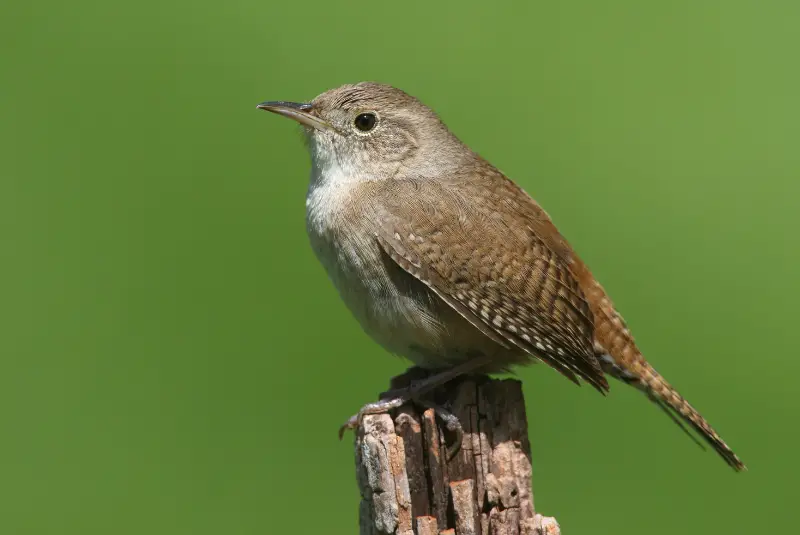
The House Wren is a small songbird with a relatively long beak. Compared to other wrens, it has a long tail, which it likes to cock up.
At a distance, House Wrens resemble uniformly brown birds, but when viewed close up, you can discern subtle barring on their wings and tail.
In contrast to the Carolina Wren, which is a year-round resident in Ohio, the House Wren is a winter visitor in Ohio, where it winters from September through April.
American Goldfinch
Scientific name: Spinus tristis
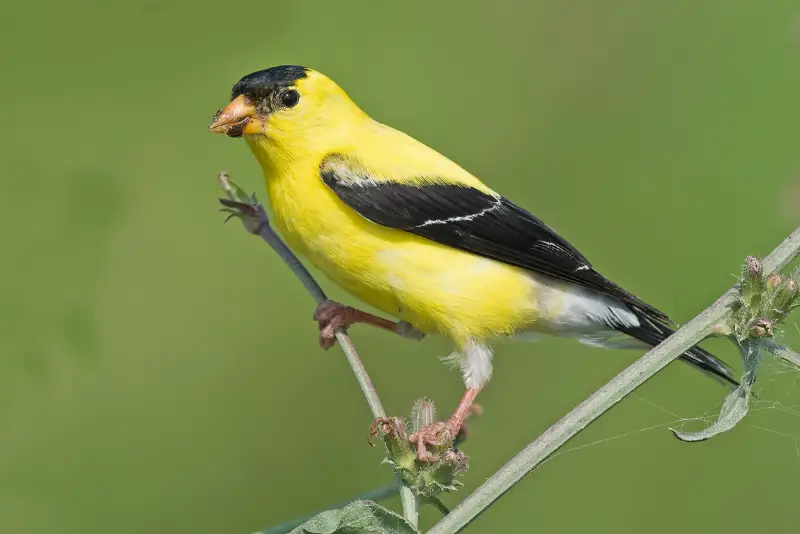
The American Goldfinch is an easily recognizable yellow bird of Ohio, due to its distinctive bright coloration.
Adult males have almost entirely bright yellow plumage, except for a black cap, black wings, and a black tail.
Females are not as brightly colored, but are more buff yellowish-brown with black wings.
It is a year-round backyard bird in Ohio, and a regular visitor at bird feeders offering sunflower seeds.
During the winter months, it forms flocks that forage together, feeding on thistles in weedy fields.
Blue-gray Gnatcatcher
Scientific name: Polioptila caerulea
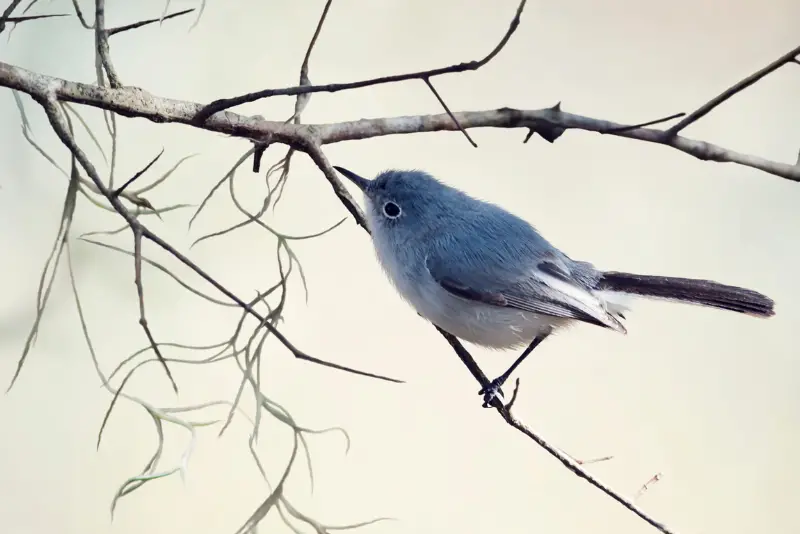
Except for its long tail, the Blue-gray Gnatcatcher looks a lot like a warbler.
The upperparts of adult males are blue-gray, while their underparts are a lighter gray. The black tail has white stripes at its margins.
Adult females and immatures are grayish on top, and light gray underparts. The eye of both sexes has a white eyering.
The Blue-gray Gnatcatcher may be encountered as a breeding bird in the temperate regions of North America, predominantly from early May through August.
It is a partial migrant, with southeastern populations being year-round residents. Northern populations, however, spend the winter in the southern USA and Central America.
A great way to identify this blue and white songbird is by its long tail that is often pointed upwards.
Palm Warbler
Scientific name: Setophaga palmarum
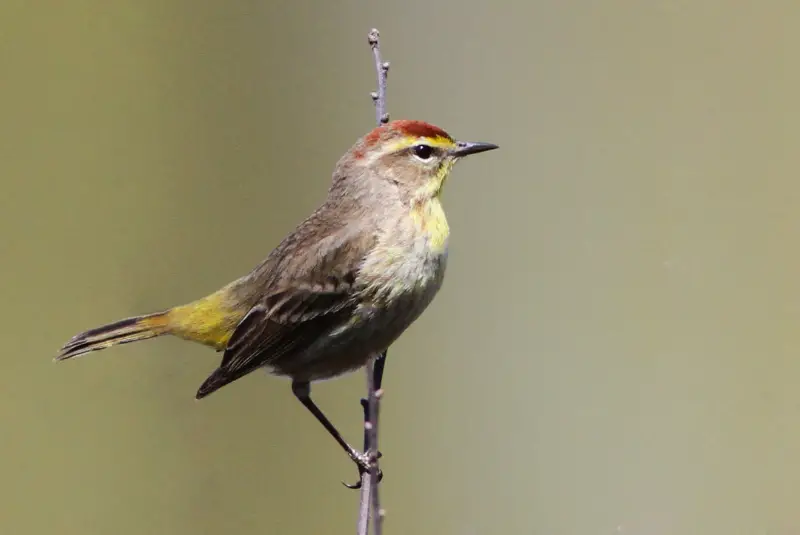
Both sexes of the Palm Warbler are quite similar to one another, with the exception that males tend to have a little more vibrant coloration than females.
The upperparts of adults are olive-brown and subtly striped, while the wings are darker overall with two light wingbars. Their underparts are mostly yellow with brown streaks.
These warblers are among the smallest birds in North America, and a great feature for identifying them is their yellow throat and yellow supercilium (eyebrow stripe).
The Palm Warbler breeds in the northern parts of North America, and passes through Ohio during migration in fall and spring.
Gray Catbird
Scientific name: Dumetella carolinensis
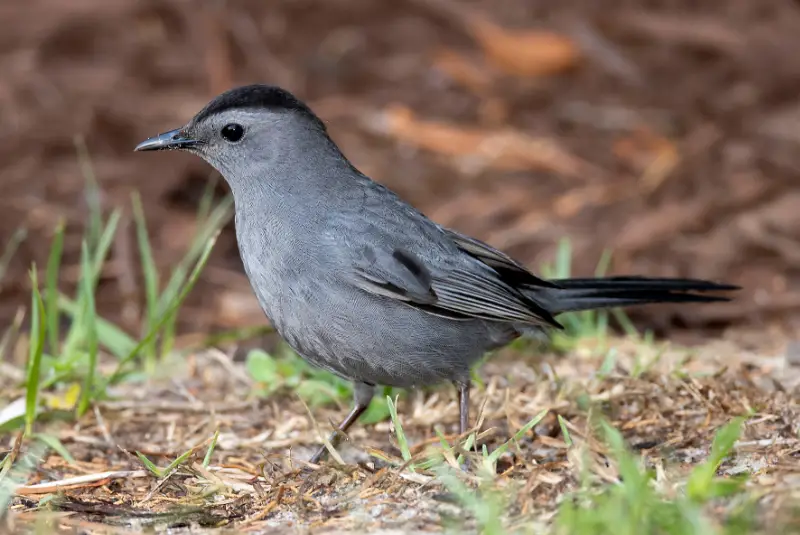
The Gray Catbird is easily recognizable due to its long tail. Both sexes and juveniles look alike and have dark gray body coloration, a black cap and a rufous red undertail.
The Gray Catbird is a scarce breeding bird in Ohio, but its numbers increase during the cold season, due to large numbers of migratory catbirds that winter in the Buckeye State.
They like to forage for insects and berries on the ground, and can be found in forests and scrubland.
They are secretive small songbirds that are hard to observe.
Tufted Titmouse
Scientific name: Baeolophus bicolor
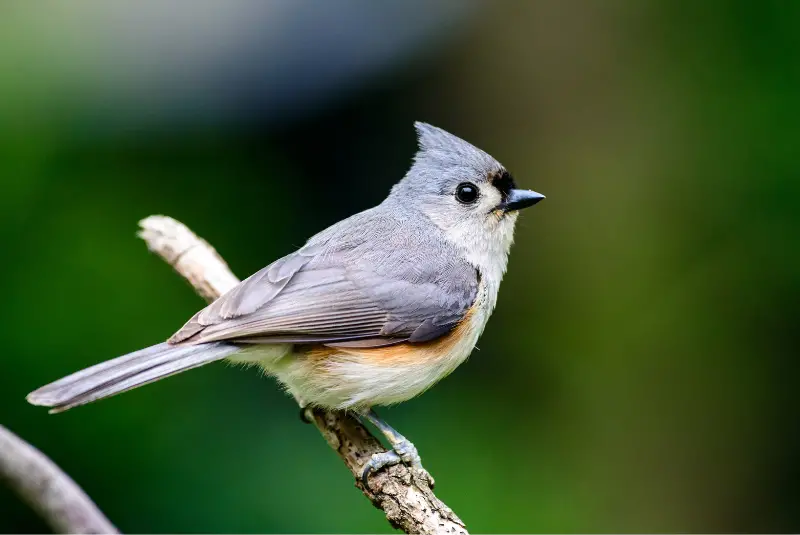
The Tufted Titmouse is a familiar and easily recognizable small songbird thanks to the distinctive crest on its head.
The sexes resemble each other, and have grayish-blue upperparts with a black forehead and a crest on the back of their head. The underparts are pale gray, but the flanks are tinged with buff orange.
This small songbird is a year-round resident throughout Ohio, and is readily observed by bird watchers, since it isn’t very shy. It is also a regular visitor at backyard feeders, and readily breeds in nestboxes.
It prefers deciduous forests, as well as parks and backyards, where it feeds on small invertebrates and seeds.
Tree Swallow
Scientific name: Tachycineta bicolor

The Tree Swallow is widespread in Ohio, and is most often found close to lakes, marshes, and ponds.
Adult Tree Swallows are greenish blue on top, and have buff white underparts. Their feathers are iridescent, and change color when viewed in direct sunlight.
While adult females look similar to adult males, young individuals are more grayish brown with a white underside.
This little swallow readily accepts suitable nesting boxes, which gives you an opportunity to attract this attractive blue-colored bird in Ohio to your backyard.
It feeds exclusively on insects that it catches in the air, and as a strict insectivore it is a long distance migrant that only spends the summer in Ohio.
Tree Swallows winter around the Gulf of Mexico, as well as in Central America.
Downy Woodpecker
Scientific name: Picoides pubescens

The Downy Woodpecker is the smallest woodpecker found in Ohio.
While males are mostly black and white with a little red patch on their nape, females are entirely black and white.
The wings of both sexes are black with white bars, which look like spots when the wings are folded.
Downy Woodpeckers are non-migratory, and can be seen all year round throughout North America, except for the arid regions in southern states.
You can tell this woodpecker apart from the Hairy Woodpecker by its smaller size and short bill.
While Downy Woodpeckers don’t migrate, they like to move around outside of the breeding season, in search of areas with plentiful food.
Their preferred habitat is deciduous or mixed forest, where they feed on insects and insect larvae found under the bark of trees. During winter they also eat berries and seeds.
Eastern Towhee
Scientific name: Pipilo erythrophthalmus
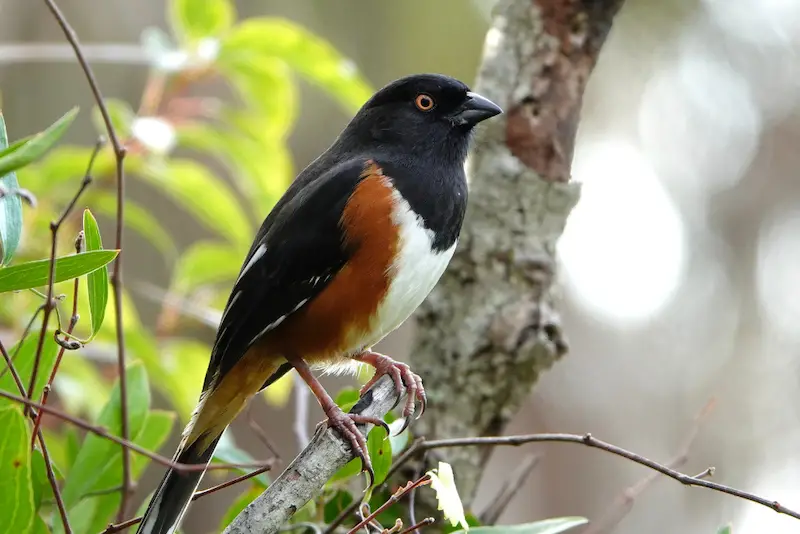
Towhees got their name from the characteristic “Tow-hee” cry that both genders use.
While Towhees don’t belong to the blackbird family, male Eastern Towhees are largely black, with rusty-brown sides and a white underside
However, its back and head are completely black, and depending on your viewing angle, it can look like an entirely black Ohio bird.
When the Eastern Towhee takes to the air, white comma-shaped wing patches become visible on the upper side of its wings.
Ohio is home to the red-eyed form of this species, which can be found year-round in the Buckeye State.
Although the female incubates the eggs until they hatch, the male does the heavy lifting when it comes to feeding the young.
The Eastern Towhee, similar to all other species of towhee, forages by making a comical backwards hopping motion with both feet at the same time.
It does this in order to displace leaves and expose the seeds and insects that are concealed under them.
You can readily attract these little songbirds to your feeder with black oil sunflower seeds.
Common Yellowthroat
Scientific name: Geothlypis trichas
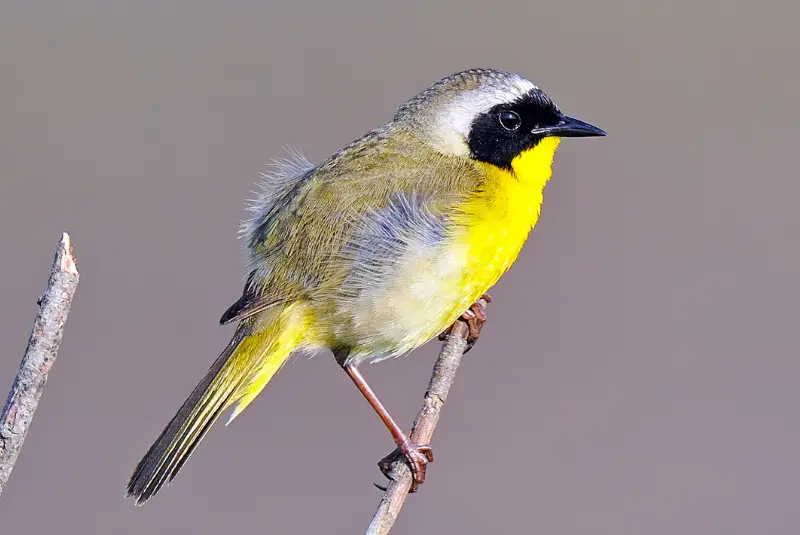
The Common Yellowthroat is a brightly colored small wood warbler. Adult males have a bright yellow throat and chest, as well as a broad black mask that covers the forehead and cheeks.
The black face mask is bordered on top by a grayish white band, which transitions into the olive brown nape and back. Females are similar, but lack the black face mask.
The Common Yellowthroat is a summer visitor and breeding bird in Ohio. It migrates south to spend the winter in the southern USA and Central America.
It prefers shrubland and grassy habitats, and feeds on insects and other invertebrates.
Scarlet Tanager
Scientific name: Piranga olivacea
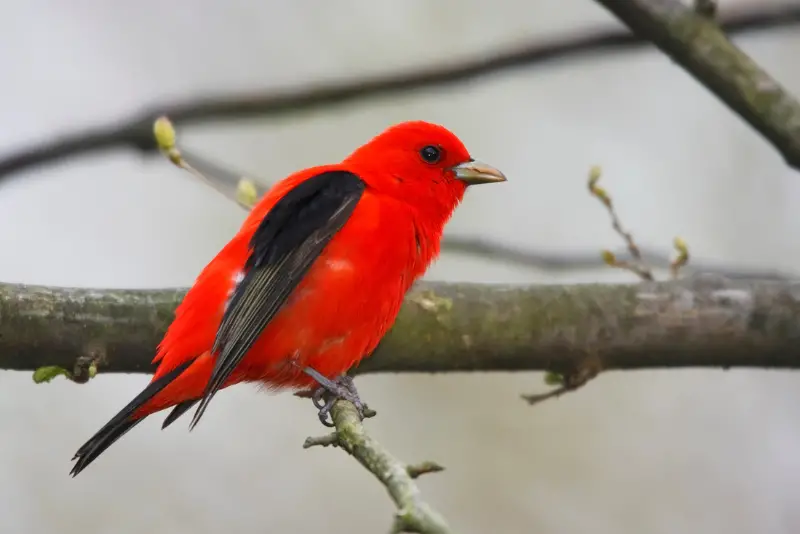
The Scarlet Tanager is a bright red bird with a tropical appearance, due to the bright scarlet plumage of the males, which contrasts with their coal-black wings and tail feathers.
But unlike the startling bright red color of the male, the female has a more drab olive yellow appearance.
The Scarlet Tanager is a summer visitor to Ohio, and spends its winter in Central and South America.
This red bird loves warm temperatures, and thus arrives late in spring, and leaves early in fall. During spring and fall, Scarlet Tanagers from Canada can be seen passing through Ohio.
Both sexes sing a similar song in order to mark and defend their territory from other birds.
Eastern Bluebird
Scientific name: Sialia sialis
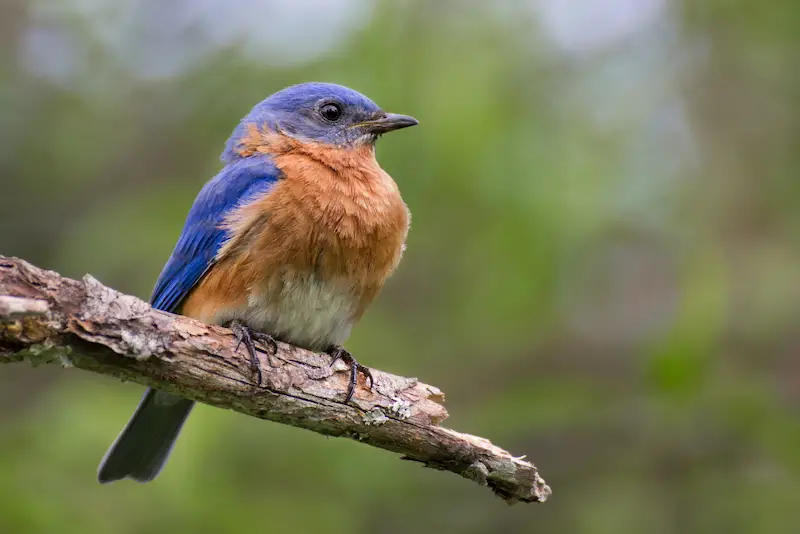
The Eastern Bluebird is a brightly colored and widespread breeding bird in Ohio.
The upperparts of adult male Eastern Bluebirds are a rich shade of admiral blue. Their blue coloration also extends to their wings, tail, and the back of their heads.
The partial orange collar of males creates the impression of having a cap on their head. Male bluebirds have a prominent orange chest, with shades of warm-toned rufous brown.
The upperparts of adult females have a more grayish-brown color. However, females also have blue tail feathers and wing feathers, as well as a rufous-orange chest and flanks.
It is a migratory bird in the northern part of its range, but can be seen year-round in the southern part of the United States. Northern populations winter in Mexico.
The Eastern Bluebird nests in holes, and competes with House Sparrows and European Starlings for nesting sites.
During their fall migration, they can be seen in flocks that like to feed on fruits and berries.
The population of Eastern Bluebirds underwent a dramatic decline at the end of last century, due to lack of nesting holes and competition with European Starlings.
But largely thanks to the efforts of numerous Ohio citizens providing nest boxes for Eastern Bluebirds, these beautiful birds are regularly observed breeding in the Buckeye State.
House Finch
Scientific name: Haemorhous mexicanus
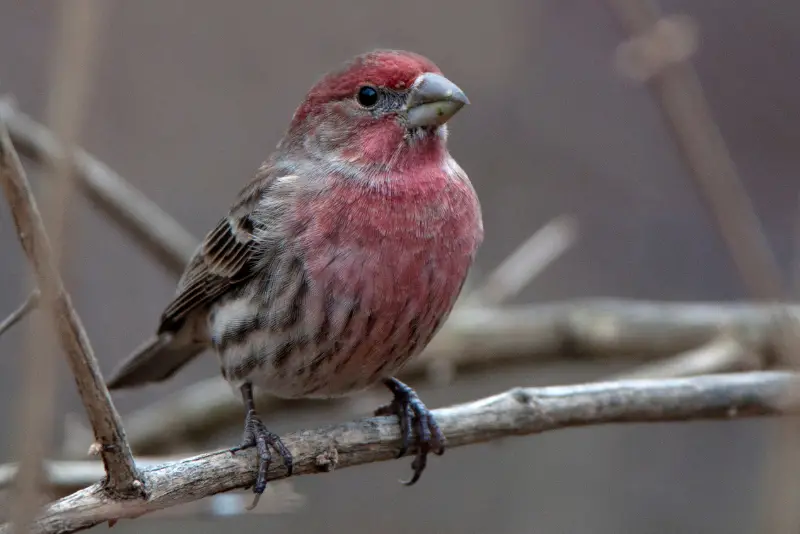
The House Finch is one of the most widespread small birds in North America, and is usually found in settled areas, ranging from little towns to large metropolitan centers.
Adult male House Finches can be identified by the bright red feathers on the head and upper breast, although in some cases they are slightly more orange or yellowish in color.
The females lack any red coloration, and instead have grayish streaks on a brown background.
The House Finch was originally a western bird, and it wasn’t until the 1940s that it was discovered in New York and other places on the east coast of the US.
The eastern House Finch population began to grow in the 1950s and 60s, and by the year 2000, it had expanded so far west that it connected with the original western population.
The House Finch is entirely herbivorous, and feeds on seeds, buds, and fruits.
If you set up a bird feeder in your backyard, you can expect House Finches to be among the first birds to visit it.
The House Finch is found in Ohio all year round, and while it is not a migratory bird, it does move to areas with more food outside of the breeding season.
Northern Cardinal
Scientific name: Cardinalis cardinalis
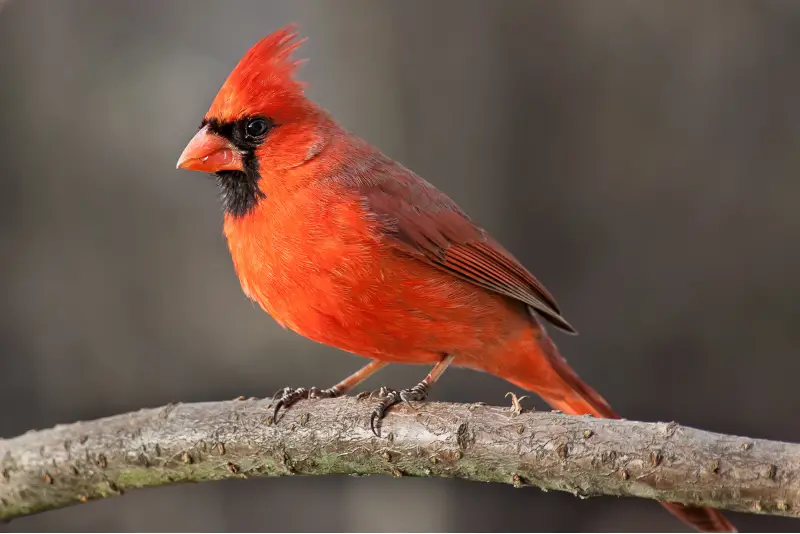
As the state bird of no less than seven US states, the Northern Cardinal is one of the most familiar red birds in Ohio.
Male Northern Cardinals have a bright crimson red coloration on their head, chest, and belly, and slightly darker red on their back and wing feathers.
In addition, the face has a black mask extending from the bright red bill to the throat.
Female Northern Cardinals are not quite as colorful as males, and have a more buff-brown body color with some reddish tinges, although they also have a bright red bill.
The Northern Cardinal is a backyard bird in Ohio, and can be seen year round in backyards, small forests, and parks.
During the winter months it doesn’t defend its territory, and sometimes gathers in flocks of up to 25 individuals that feed together. The Northern Cardinal is a regular visitor at bird feeders.
House Sparrow
Scientific name: Passer domesticus
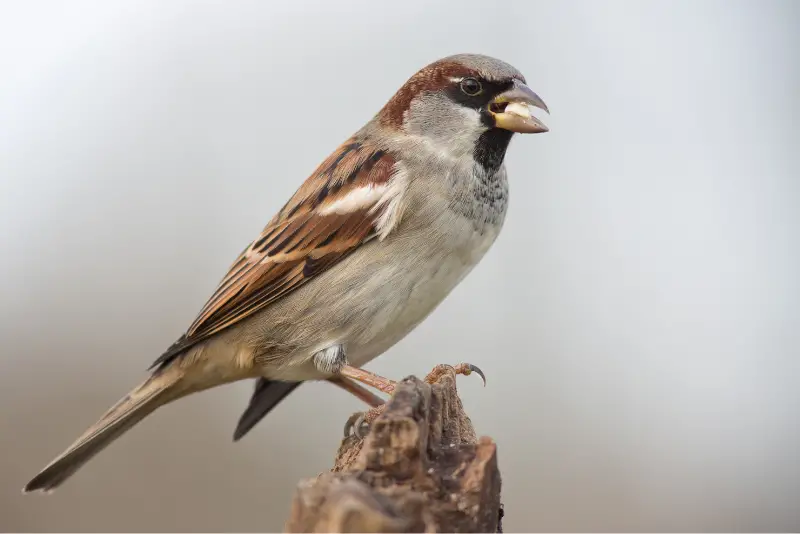
The House Sparrow is a common urban songbird in Ohio.
Adult males have upperparts that are primarily chestnut brown with dark streaks. The wings are chestnut brown with a white wingbar.
A great characteristic to identify males is by their gray crown and rump. Females are more drab, and are mostly buff gray with dark streaks on their back.
The House Sparrow is not a native bird of Ohio, but was introduced by European settlers.
However it has successfully colonized the entire North American continent, and is now an urban bird that is found in parks and backyards.
Yellow Warbler
Scientific name: Setophaga petechia
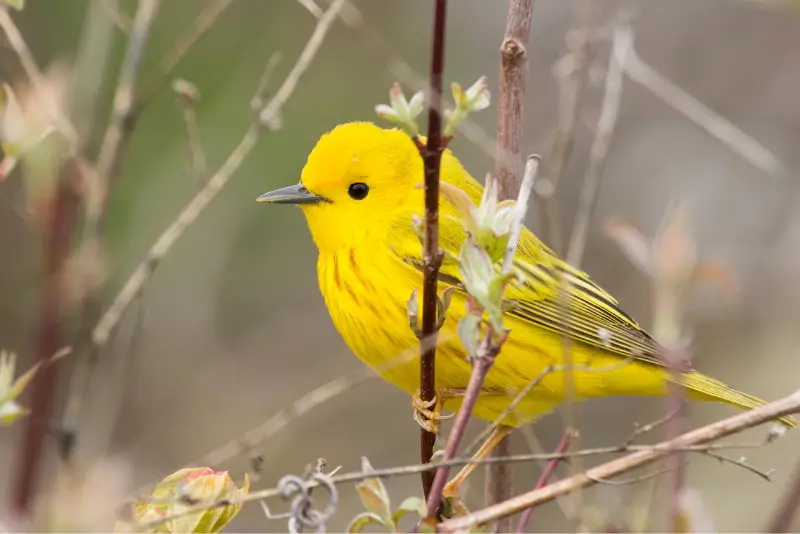
Also known as the American Yellow Warbler, this songbird lives up to its name.
Adult males have a brilliant yellow color, except for their wings, which are just slightly darker and have two pale wingbars.
They also have reddish stripes on the breast and the sides. Adult females are very similar to the males, but have less streaking and are thus more uniformly yellow.
This yellow bird is present as a breeding species in Ohio from April through August, and spends the rest of the year in Central America and South America.
It favors open habitat with low thickets and scrubland, which makes it easy to observe.
Red-breasted Nuthatch
Scientific name: Sitta canadensis
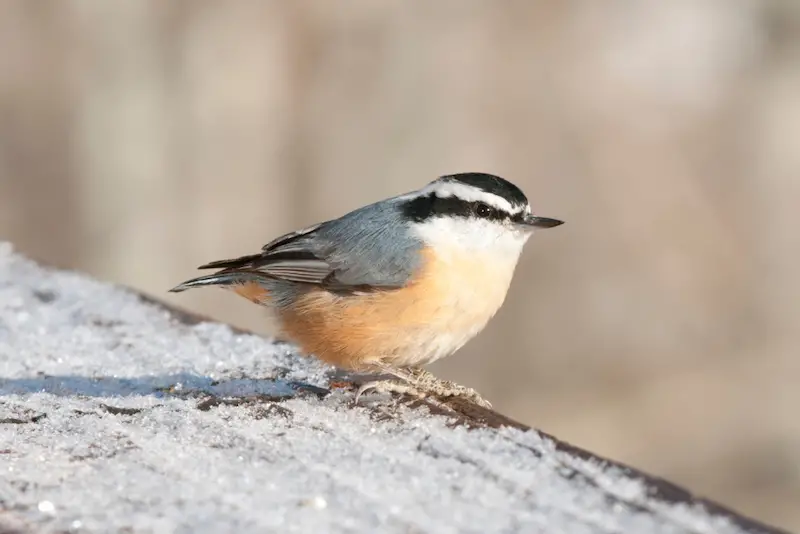
The Red-breasted Nuthatch is a visitor at bird feeders, and also accepts nesting boxes that are put up well before the breeding season.
Adult male Red-breasted Nuthatches have rusty orange underparts, as well as blue-gray upperparts and a black eye stripe that contrasts with their white cheeks and eyebrows.
Females and immatures have slightly paler orange underparts.
In the eastern part of their range, Red-breasted Nuthatches can be found in coniferous forests in lowlands and hills. In the western part, however, they inhabit mountainous areas.
The Red-breasted Nuthatch is a talented climber, and can use its robust claws to climb in any direction on a tree trunk.
It is often observed upside down while feeding on insects it excavates from under the tree’s bark.
In addition to eating insects, it also feeds on seeds and nuts, which it can store for later use, similar to squirrels.
In order to open a nut, it will place the nut in a crack of bark, and then hammer it with its beak.
Nuthatches dig out nest cavities in pine trees, and also use mud to adjust the size of the opening.
Red-breasted Nuthatches can be found in northern Ohio year round, while they only occur during the winter in southern parts of the state.
Golden-crowned Kinglet
Scientific name: Regulus satrapa

The Golden-crowned Kinglet is another tiny songbird. Adults have a grayish green back and dark wings with two light wing bars.
Their most distinguishing feature is the black cap with a bright orange stripe along the centerline.
And while females and immatures look similar to males, their crown stripe is yellow instead of orange.
The Golden-crowned Kinglet is a winter visitor throughout Ohio, and occurs in the state from October through March.
Outside of the breeding season, these little birds form mixed flocks with other songbirds that forage together.
Brown Creeper
Scientific name: Certhia americana
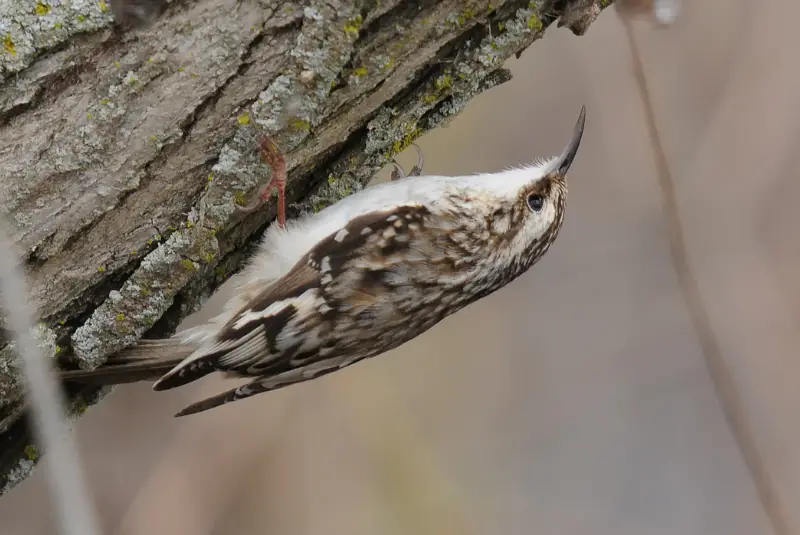
The Brown Creeper is hard to confuse with any other species of birds. It is a diminutive brown bird in Ohio with a down curved bill that can be seen climbing tree trunks like a little rodent.
While the upperparts are dark gray with brown streaks, the underparts are buff white. The sexes both look alike.
The Brown Creeper is a winter visitor in Ohio, and favors a wide variety of woodland habitats.
What are the small brown birds in Ohio?
The small brown birds found in Ohio backyards are most often wrens, which are tiny birds with a loud voice.
During the summer months, the most common wren species in Ohio is the House Wren.
But if you spot a wren during winter, this is likely to be a Carolina Wren, since these don’t migrate south (while House Wrens do).
In addition to wrens, female House Finches are also small birds that are brownish gray, and are often found in backyard gardens all over the Buckeye State.
If you’re not sure which one of these birds you spotted while bird watching in Ohio, check out our detailed ID guides with photos above.
And if you enjoyed this article, check out our guide to the birds of prey in Ohio.
